Battle of the Coral Sea order of battle
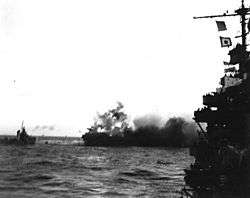
This is an order of battle for the Battle of the Coral Sea. The battle, fought during 4–8 May 1942, was a major naval battle in the Pacific Theater of World War II between the Imperial Japanese Navy and Allied naval and air forces from the United States (U.S.) and Australia.
In an attempt to strengthen their defensive positioning for their empire in the South Pacific, Imperial Japanese forces decided to invade and occupy Port Moresby in New Guinea and Tulagi in the southeastern Solomon Islands. The plan to accomplish this, called Operation MO, involved several major units of Japan's Combined Fleet, including two fleet carriers and a light carrier to provide air cover for the invasion fleets, under the overall command of Shigeyoshi Inoue. The U.S. learned of the Japanese plan through signals intelligence and sent two United States Navy carrier task forces and a joint Australian-American cruiser force, under the overall command of Frank Jack Fletcher, to oppose the Japanese offensive.
Japanese Forces
Task Force MO
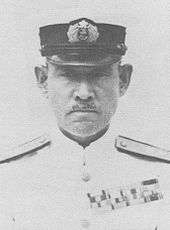



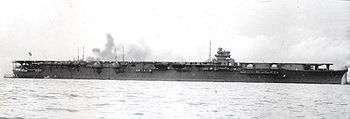
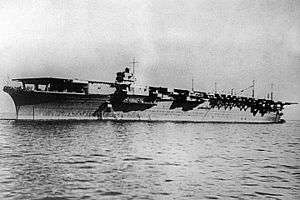
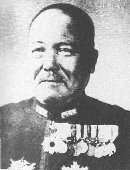
- IJN 4th Fleet – Vice Admiral Shigeyoshi Inoue[1]
- light cruiser Kashima (Inoue's flagship, anchored at Rabaul during the battle)[2]
- Tulagi Invasion Group – Rear Admiral Kiyohide Shima[3]
- minelayers Okinoshima (Shima's flagship), Kōei Maru[4]
- transport Azumasan Maru[3]
- destroyers Kikuzuki (sunk), Yūzuki[5]
- minesweepers Wa #1 (sunk), Wa #2 (sunk), Hagoromo Maru, Noshiro Maru #2, and Tama Maru (sunk)[6]
- subchasers Toshi Maru #3 and Tama Maru #8[7]
- 400 troops from the 3rd Kure Special Naval Landing Force (SNLF) plus a construction detachment from the 7th Establishment Squad.[8]
- Support Group/Close Cover Force – Rear Admiral Kuninori Marumo[9]
- light cruisers Tenryū (Marumo's flagship), Tatsuta[10]
- seaplane tender Kamikawa Maru[11]
- Kamikawa Maru air group – 12 aircraft[12]
- Kiyokawa Maru air group (attached)[13]
- gunboats Keijo Maru, Seikai Maru, Nikkai Maru[14]
- Covering Group/Main Body Support Force – Rear Admiral Aritomo Gotō[15]
- light carrier Shōhō (sunk)[16]
- Shōhō Air Group – Lieutenant Kenjirō Nōtomi[17]
- Shōhō Carrier Fighter Unit – 8 Mitsubishi A6M Zero and 4 Mitsubishi A5M fighters[18]
- Shōhō Carrier Attack Unit – 6 Nakajima B5N Type 97 torpedo bombers[19]
- cruisers Aoba (Gotō's flagship), Kako, Kinugasa, Furutaka[20]
- destroyer Sazanami[21]
- Port Moresby Invasion Group – Rear Admiral Sadamichi Kajioka[22]
- light cruiser Yūbari (Kajioka's flagship)[23]
- destroyers Oite, Asanagi, Uzuki, Mutsuki, Mochizuki, Yayoi[24]
- 1 or 2 unidentified patrol boats[25]
- Transport Unit – Rear Admiral Kōsō Abe
- minelayer Tsugaru[26]
- 11 transports:
- Imperial Japanese Navy (IJN)- Mogamigawa Maru, Chōwa Maru, Goyō Maru,[27] Akiba Maru, Shōka Maru.[28]
- Imperial Japanese Army (IJA)- Asakasan Maru, China Maru, Mito Maru, Matsue Maru,[29] Taifuku Maru, Hibi Maru[28]
- salvage tugboat Woshima[30]
- oilers Hoyo Maru, and Irō[31]
- minesweepers W-20 (Wa #20), Hagoromo Maru, Noshiro Maru #2, Fumi Maru #2, and Seki Maru #3.[32]
- Approximately 500 troops from the 3rd Kure SNLF plus construction specialists from the 10th Establishment Squad on the IJN transports[33]
- South Seas Detachment of approximately 5,000 troops on the IJA transports[34]
- Carrier Striking Force – Vice Admiral Takeo Takagi[35]
- Carrier Division 5 – Rear Admiral Chūichi Hara, Officer in Tactical Command[1]
- Carrier Shōkaku[36]
- Shōkaku Air Group – Lieutenant Commander Kakuichi Takahashi[37]
- Carrier Zuikaku (Hara's flagship)[41]
- Zuikaku Air Group – Lieutenant Commander Shigekazu Shimazaki[42]
- Zuikaku Carrier Fighter Unit – 25 Mitsubishi A6M Zero fighters[43]
- Zuikaku Carrier Bomber Unit – 22 Aichi D3A dive bombers[44]
- Zuikaku Carrier Attack Unit – 20 Nakajima B5N torpedo bombers[45]
- cruisers Myōkō (Takagi's flagship), Haguro[46]
- destroyers Ushio, Akebono[47]
- destroyers Ariake, Yūgure, Shiratsuyu, Shigure[48]
- oiler Tōhō Maru[35]
- Carrier Division 5 – Rear Admiral Chūichi Hara, Officer in Tactical Command[1]
- Submarine Force – Captain Noburu Ishizaki
- 25th Air Flotilla (also called the 5th Air Attack Force) – Rear Admiral Sadayoshi Yamada[51]
- 4th Air Group (based at Rabaul) – 17 Mitsubishi G4M Type 1 land attack bombers[52]
- Tainan Air Group (based at Lae and Rabaul) – 18 Mitsubishi A6M Zero and six Mitsubishi A5M fighters[53]
- Yokohama Air Group (based at Rabaul, Shortland Islands, and Tulagi) – 12 Kawanishi H6K reconnaissance and nine Nakajima A6M2-N seaplane fighters[54]
- Genzan Air Group (based at Rabaul) – 25 Mitsubishi G3M Type 96 land attack bombers[55]
Allied Forces
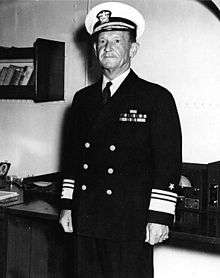
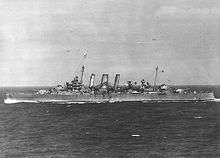
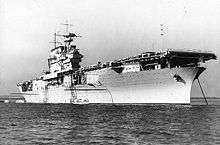
_leaving_San_Diego_on_14_October_1941.jpg)
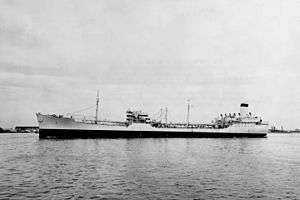
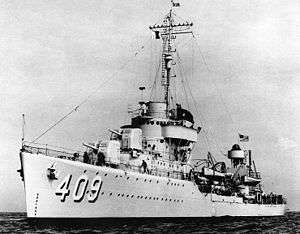

Task Force 17 – Vice Admiral Frank Jack Fletcher[56]
- Task Group 17.2 (Attack Group) – Rear Admiral Thomas C. Kinkaid[56]
- Task Group 17.3 (Support Group, from Task Force 44) – Rear Admiral John Gregory Crace[56]
- Task Group 17.5 (Carrier Air Group) – Rear Admiral Aubrey Fitch, Officer in Tactical Command (OTC)[61]
- carrier Yorktown[62]
- Yorktown Air Group – Lieutenant Commander Oscar Pederson[63]
- Fighting 42 (VF-42) – 17 Grumman F4F Wildcat fighters[64]
- Bombing 5 (VB-5) – 18 Douglas SBD Dauntless dive bombers[65]
- Scouting 5 (VS-5) – 17 SBD Dauntless dive bombers[66]
- Torpedo 5 (VT-5) – 13 Douglas TBD Devastator torpedo bombers[67]
- carrier Lexington (sunk)[68]
- Lexington Air Group – Commander William B. Ault[69]
- Fighting 2 (VF-2) – 21 F4F Wildcat fighters[70]
- Bombing 2 (VB-2) – 18 SBD Dauntless dive bombers[71]
- Scouting 2 (VS-2) – 17 SBD Dauntless dive bombers[72]
- Torpedo 2 (VT-2) – 12 TBD torpedo bombers[73]
- destroyers Morris, Anderson, Hammann, Russell[74]
- Task Group 17.6 (Fueling Group) – Captain John S. Phillips[56]
- Task Group 17.9 (Search Group) – Commander George H. DeBaun[56]
South West Pacific Area – General Douglas MacArthur[77]
- Allied Naval Forces – Vice Admiral Herbert F. Leary[77]
- Task Group 42.1 – Captain Ralph Waldo Christie in submarine tender USS Griffin at Brisbane[78]
- Task Force 44 – temporarily assigned to Task Force 17, see Task Group 17.3 above
- Allied Air Forces – Lieutenant General George Brett[79]
- United States Army Air Forces:
- 8th Pursuit Group – Archerfield, Brisbane, 26 P-39 Airacobras[80]
- 35th Fighter Squadron – Port Moresby[81]
- 36th Fighter Squadron – Port Moresby[81]
- 49th Pursuit Group – Darwin, 90 Curtiss P-40s[82]
- 7th Fighter Squadron – Darwin[81]
- 8th Fighter Squadron – Darwin[81]
- 9th Fighter Squadron – Darwin[81]
- 3rd Light Bombardment Group -[81]
- 8th Light Bombardment Squadron – Port Moresby, Douglas A-24 Dauntless dive bombers[83]
- 13th Light Bombardment Squadron – North American B-25 Mitchells[81]
- 90th Light Bombardment Squadron – B-25 Mitchells[81]
- 19th Bombardment Group – Townsville, 17 B-17s[84]
- 22nd Bombardment Group – 48 Martin B-26 Marauders[89]
- 8th Pursuit Group – Archerfield, Brisbane, 26 P-39 Airacobras[80]
- Royal Australian Air Force[90]
- No. 11 Squadron – Consolidated PBY Catalinas[90]
- No. 20 Squadron – PBY Catalinas[90]
- No. 24 Squadron – Townsville, 3 CAC Wirraways
- No. 32 Squadron – Port Moresby, Lockheed Hudsons[91]
- No. 75 Squadron – Port Moresby, 3 Curtiss P-40s[90]
- United States Army Air Forces:
- Port Moresby garrison – approximately 5,000 troops under Major General B. M. Morris[92]
- 30th Infantry Brigade[93]
- 39th Infantry Battalion[94]
- 49th Infantry Battalion[95]
- 53rd Infantry Battalion[96]
- 13th Field Regiment[97]
- 23rd Heavy Anti-Aircraft Battery[98]
- Detachment, 1st Independent Company[93]
- 30th Infantry Brigade Signal Section[93]
- 30th Infantry Brigade HQ Defence Platoon[93]
- Moresby Fixed Defences[93]
- 1st Army Troops Company[93]
- 7th Field Company[93]
- 1st Section, 1st Mechanical Equipment Company[93]
- 8th Military District Survey Section[93]
- 8th Military District Bomb Disposal Section[93]
- 8th Military District Signals[93]
- 8th Military District Defence and Employment Company[93]
- New Guinea Volunteer Rifles[99]
- Papuan Infantry Battalion[100]
- 8th Military District Section Intelligence Corps[93]
- 15th Supply Personnel Company[93]
- 8th Military District Bulk Issue Petrol and Oil Depot[93]
- A Section, 8th Military District Mechanical Transport Company[93]
- Base Hospital[93]
- 3rd Field Ambulance[93]
- 113th Convalescent Depot[93]
- 8th Military District Dental Centre[93]
- 15th Optical Unit[93]
- 8th Military District Depot of Medical Stores[93]
- 16th Field Hygiene Section[93]
- 8th Military District Ordnance Depot[93]
- 19th Ordnance Ammunition Section[93]
- 109th Infantry Brigade Group Field Workshop[93]
- 109th Infantry Brigade Group Ordnance Field Park[93]
- 30th Infantry Brigade Provost Platoon[93]
- 8th Military District Accounts Office[93]
- 8th Military District Postal Unit[93]
- 8th Military District Records Office[93]
- 8th Military District Stationery Depot[93]
- 8th Military District Printing Section[93]
- 8th Military District Graves Registration and Inquiries Unit[93]
- 8th Military District Laundry and Decontamination Unit[93]
- 8th Military District Army Field Bakery[93]
- 8th Military District Base Depot[93]
- 8th Military District Marine Section[93]
- 8th Military District Canteen Services[93]
- 8th Military District Training Centre[93]
- Australian New Guinea Administrative Unit[93]
- 30th Infantry Brigade[93]
References
| Wikimedia Commons has media related to Battle of the Coral Sea. |
Notes
- 1 2 Lundstrom (2006), p. 138.
- ↑ Lundstrom (2006), p. 147; Bullard, pp. 51–52.
- 1 2 Willmott, p. 84.
- ↑ Okinoshima was commanded by Captain Nomi Minoru and was flagship of Mine Division 19. Okinoshima was sunk by US submarine S-42 on 10 May 1942 during Operation RY. Hackett, Okinoshima.
- ↑ From Destroyer Squadron 6 (Bullard, p. 56 says Destroyer Squadron 23). Willmott, p. 84; Dull, p. 136.
- ↑ The latter three ships were from the 14th Minesweeper Flotilla. Bullard, p. 56; Willmott, p. 84.
- ↑ From the 56th Submarine Chaser Squadron. Bullard, p. 56; Willmott, p. 84.
- ↑ Bullard, p. 56; Jersey, pp. 58–60.
- ↑ Hackett, Tenryu. Marumo also commanded Cruiser Division 18.
- ↑ Cruiser Division 18. Gill, p. 40; Bullard, p. 52; Hackett, Tenryu and Tatsuta. Tatsuta's commander was Captain Yoshifumi Baba and Tenryu's was Captain Mitsutaru Goto (Hackett).
- ↑ Dull, p. 136.
- ↑ Hackett, Tenryu; United States Army Center of Military History, p. 135.
- ↑ Kiyokawa Maru was under repair at Yokohama, Japan but its airgroup was at Rabaul and assisted Kamikawa Maru'ss airgroup in the invasion of Tulagi. When Kamikawa Maru departed Santa Isabel on 4 May to support the Port Moresby invasion from Deboyne, the Kiyokawa Maru aircraft remained at Santa Isabel and Tulgai and/or were attached to Kamikawa's airgroup for the Deboyne deployment. Hackett, Tenryu and Kiyokawa Maru.
- ↑ Nikkai Maru and oiler Iro helped establish a Japanese port and seaplane base in the Shortland Islands on 28 April 1942 prior to participating in Mo. Willmott, p. 84.
- ↑ Gotō was in tactical command of the Mo invasion forces. Willmott, pp. 85–86.
- ↑ Willmott, pp. 85–86.
- ↑ Lundstrom (2005), p. 188.
- ↑ Lundstrom (2005), p. 188. Commanded by Nōtomi.
- ↑ Lundstrom (2005), p. 188. Commanded by Lieutenant Michitarō Nakamoto.
- ↑ Cruiser Division 6. On 8 May Furutaka and Kinugasa were attached to Carrier Division 5 and helped escort Zuikaku back to Truk. Aoba and Kako helped cover the Port Moresby invasion convoy's return to Rabaul. Bullard, p. 52; Willmott, pp. 85–86; Hackett, Furutaka; Gill, p. 40.
- ↑ Dull, p. 136; Willmott, pp. 85–86.
- ↑ Also commander of Destroyer Squadron 6. Hackett, Yubari.
- ↑ Willmott, p. 86; Dull, p. 135; Hackett, Yubari. Flagship of Destroyer Squadron 6. Commanded by Captain Masami Ban (Hackett).
- ↑ Oite and Asanagi were from Destroyer Squadron 29, Mutsuki, Mochizuki, and Yayoi from Destroyer Squadron 30, and Uzuki from Destroyer Squadron 23. Bullard, p. 56; Willmott, p. 86.
- ↑ Hackett, Ojima.
- ↑ Member of Mine Division 19 with Okinoshima. Commanded by Captain Inagaki Yoshiaki. Hackett, Tsugaru.
- ↑ Goyo Maru was later converted into an oiler. Willmott, p. 86; Bullard, pp. 56–57. Apparently, the Azumasan Maru was supposed to join from the Tulagi Invasion Group but did not, perhaps as a result of battle damage (Bullard, pp. 56–57). Willmott spells Akihasan Maru as Akibasan Maru.
- 1 2 Iwashige (2009), p. 78–79
- ↑ Bullard, p. 58, 64; Willmott, p. 86; Dull, p. 135; Hackett, Tsugaru. Asakayama Maru was equipped with extra anti-aircraft guns (Bullard). The IJA commander was on Matsue Maru (Bullard).
- ↑ Bullard, pp. 56–57; Willmott, p. 86; Hackett, Tsugaru. Some sources spell this ship's name as Oshima. Her ship's side name is をしま, not おしま おじま.
- ↑ Iro and gunboat Nikkai Maru helped establish a Japanese port and seaplane base in the Shortland Islands on 28 April 1942 prior to participating in Mo. Iro and destroyer Uzuki remained at the Shortlands to refuel Gotō's Covering Group after it completed its support mission of the Tulagi invasion. Hackett, Ojima; Willmott, pp. 84, 86; Hackett, Tsugaru.
- ↑ All the minesweepers from Shima's Tulagi Invasion Group were to have joined the Port Moresby Invasion Group. Only Hagoromo Maru and Noshiro Maru #2 survived the Yorktown's airstrikes to do so. Bullard, pp. 56–57; Willmott, pp. 85–86; Hackett, Tsugaru. Hackett does not list Seki Maru #3 as part of Abe's force.
- ↑ Bullard, pp. 56–57.
- ↑ The South Seas Detachment was primarily from the 55th Division commanded by Major General Tomitarō Horii and included troops from the 55th Infantry Group, centered on the 144th Infantry Regiment, as well as the 47th Field Anti-Aircraft Battalion and attached medical and water supply support units. Rottman, p. 84.
- 1 2 Willmott, p. 87.
- ↑ Captained by Takaji Jōjima. Lundstrom, p. 140; Willmott, p. 87.
- ↑ Lundstrom (2005), p. 188. Flew in an Aichi D3A dive bomber.
- ↑ Gillison, p. 525; Lundstrom (2005), p. 188. Commanded by Lieutenant Takumi Hoashi. Three aircraft were reserved for delivery to the Tainan Air Group.
- ↑ Gillison, p. 525; Lundstrom (2005), p. 188. Commanded by Lieutenant Masao Yamaguchi.
- ↑ Lundstrom (2005), p. 188. Commanded by Lieutenant Tatsuo Ichihara.
- ↑ Captained by Ichihei Yokogawa. Lundstrom (2006), p. 140; Willmott, p. 87.
- ↑ Lundstrom (2005), p. 188. Shimazaki flew in a Nakajima B5N torpedo bomber.
- ↑ Lundstrom (2005), p. 188. Commanded by Lieutenant Kiyokuma Okajima. Five of the fighters were reserved for delivery to the Tainan Air Group.
- ↑ Lundstrom (2005), p. 188. Commanded by Lieutenant Tamotsu Ema.
- ↑ Lundstrom (2005), p. 188. Commanded by Lieutenant Yoshiaki Tsubota.
- ↑ From Cruiser Division 5. Gill, p. 40; Willmott, p. 87; Bullard, p. 52.
- ↑ From Destroyer Squadron 7. Willmott, p. 87; Bullard, p. 52.
- ↑ From Destroyer Squadron 27. Willmott, p. 87; Bullard, p. 52; Dull, p. 135.
- ↑ From Submarine Squadron 8. I-28 was sunk by the US submarine Tautog on 17 May as I-28 returned to base at Truk. Willmott, pp. 84–85.
- ↑ From the 21st Submarine Group. Bullard, p. 57.
- ↑ Bullard, pp. 47, 61. Aircraft numbers are of 1 May 1942.
- ↑ Bullard, pp. 47, 53, 61.
- ↑ commanded by Captain Masahisa Saitō. Bullard, pp. 47, 53–54, 61.
- ↑ Six Kawanishi deployed from Rabaul to the Shortlands on 28 April. Lundstrom (2006), p. 138; Bullard, pp. 48, 52, 61.
- ↑ Bullard, p. 61; Crave, p. 447. Crave states the Genzan had 27 aircraft.
- 1 2 3 4 5 Willmott, p. 190; Lundstrom (2006), p. 519.
- ↑ Minneapolis and New Orleans were designated Task Unit 17.2.1 under Kinkaid and the other three cruisers were Task Unit 17.2.2 under Rear Admiral William W. Smith. Captains of each ship (all at the rank of Captain): Minneapolis- Frank J. Lowry, New Orleans- Howard H. Good, Astoria- Francis W. Scanland, Chester- Thomas M. Shock, Portland- Benjamin Penman. Office of Naval Intelligence (ONI), p. 10; Lundstrom (2006), p. 519.
- ↑ Task Unit 17.2.4 under Captain Alexander R. Early. Captains of each ship: Phelps- Lieutenant Commander Edward L. Beck, Dewey- Lieutenant Commander Charles F. Chillingworth, Jr., Farragut- Commander George P. Hunter, Aylwin- Lieutenant Commander Robert H. Rogers, Monaghan- Lieutenant Commander William P. Burford. ONI, p. 10; Lundstrom (2006), p. 519.
- ↑ Task Unit 17.3.1 under Crace. Cruiser captains: Australia- Captain H. B. Farncomb, Chicago- Captain Howard D. Bode, Hobart- Captain H. L. Howden. ONI, p. 10; Lundstrom (2006), p. 519.
- ↑ Task Unit 17.3.4 under Commander Francis X. McInerney. Destroyer captains (Lieutenant commanders): Perkins- Walter C. Ford, Walke- Thomas E. Fraser. ONI, p. 10; Lundstrom (2006), p. 519.
- ↑ Both carriers together were designated Task Unit 17.5.1 under Fitch. Willmott, p. 190; Lundstrom (2006), p. 519.
- ↑ Skippered by Captain Elliott Buckmaster. ONI, p. 11; Lundstrom (2006), p. 519.
- ↑ Lundstrom (2005), p. 190.
- ↑ Lundstrom (2005), p. 190. Commanded by Lieutenant Commander Charles R. Fenton.
- ↑ Lundstrom (2005), p. 190. Commanded by Lieutenant Wallace C. Short.
- ↑ Lundstrom (2005), p. 190. Commanded by Lieutenant Commander William O. Burch, Jr.
- ↑ Lundstrom (2005), p. 190. Commanded by Lieutenant Commander Joe Taylor.
- ↑ Skippered by Captain Frederick C. Sherman. ONI, p. 11; Lundstrom (2006), p. 519.
- ↑ Lundstrom (2005), p. 190. Ault flew an SBD not assigned to either of the SBD squadrons.
- ↑ Lundstrom (2005), p. 190. Commanded by Lieutenant Commander Paul H. Ramsey.
- ↑ Lundstrom (2005), p. 190. Commanded by Lieutenant Commander Weldon L. Hamilton.
- ↑ Lundstrom (2005), p. 190. Commanded by Lieutenant Commander Robert E. Dixon.
- ↑ Lundstrom (2005), p. 190. Commanded by Lieutenant Commander James H. Brett, Jr.
- ↑ Task Unit 17.5.4 under Captain Gilbert C. Hoover. Destroyer skippers: Morris- Commander Harry B. Jarrett, Anderson- Lieutenant Commander John K. B. Ginder, Hammann- Lieutenant Commander Arnold E. True, Russell- Lieutenant Commander Glenn R. Hartwig. ONI, p. 11; Lundstrom (2006), p. 519.
- 1 2 Lundstrom (2006), p. 519.
- ↑ Dull, p. 136; Hoyt, p. 13; Willmott, p. 190; Lundstrom (2006), p. 519; Morison, p. 20.
- 1 2 Willmott, p. 191.
- ↑ Gill, p. 42; Morison, p. 20; Willmott, p. 191. Only S-38, S-42, S-44, and S-47 were involved in the battle.
- ↑ Willmott, p. 192.
- ↑ Willmott, p. 195; Crave, pp. 424–425.
- 1 2 3 4 5 6 7 8 Willmott, p. 195.
- ↑ Willmott, p. 195; Crave, pp. 411, 416.
- ↑ Willmott, p. 195; Crave, p. 425.
- ↑ Willmott, p. 195; Crave, p. 416; Salecker, p. 177. Commanded by Lieutenant Colonel Connally (first name unknown).
- ↑ Bowman, p. 85.
- ↑ Salecker, p. 177.
- ↑ Bowman, p. 85; Salecker, p. 177.
- ↑ Crave, pp. 425, 448.
- ↑ Willmott, p. 195; Crave, pp. 414, 425.
- 1 2 3 4 Willmott, p. 196.
- ↑ Willmott, p. 196; Gillison, p. 519.
- ↑ Willmott, p. 143; McCarthy, p. 112.
- 1 2 3 4 5 6 7 8 9 10 11 12 13 14 15 16 17 18 19 20 21 22 23 24 25 26 27 28 29 30 31 32 33 34 35 36 37 38 39 40 41 42 43 44 45 46 47 48 49 ""Order of Battle – Port Moresby Garrison", War Diary, New Guinea Force Headquarters, March–April 1942, AWM52 1/5/51" (PDF). Retrieved 28 November 2009.
- ↑ McCarthy, p. 44. Commanded by Lieutenant Colonel H. M. Conran.
- ↑ McCarthy, pp. 43–44.
- ↑ Willmott, p. 143.
- ↑ McCarthy, p. 45.
- ↑ McCarthy, p. 45. Consisted of four 3.7 inch stationary guns and three mobile 3 inch guns.
- ↑ McCarthy, p. 42, 45.
- ↑ McCarthy, p. 45. Commanded by Major W. T. Watson.
Printed sources
- Bowman, Martin (2003). B-17 Flying Fortress Units of the Pacific War. Great Britain: Osprey Publishing. ISBN 1-84176-481-7.
- Dull, Paul S. (1978). A Battle History of the Imperial Japanese Navy, 1941–1945. Naval Institute Press. ISBN 0-87021-097-1.
- Hoyt, Edwin Palmer (2003). Blue Skies and Blood: The Battle of the Coral Sea. I Books. ISBN 0-7434-5835-4.
- Jersey, Stanley Coleman (2008). Hell's Islands: The Untold Story of Guadalcanal. College Station, Texas: Texas A&M University Press. ISBN 1-58544-616-5.
- Lundstrom, John B. (2006). Black Shoe Carrier Admiral: Frank Jack Fletcher at Coral Sea, Midway, and Guadalcanal. Annapolis, Maryland: Naval Institute Press. ISBN 1-59114-475-2.
- Lundstrom, John B. (2005). The First Team: Pacific Naval Air Combat from Pearl Harbor to Midway (New ed.). Annapolis, Maryland: Naval Institute Press. ISBN 1-59114-471-X.
- Morison, Samuel Eliot (2001) [1949]. Coral Sea, Midway and Submarine Actions, May 1942 – August 1942, vol. 4 of History of United States Naval Operations in World War II. Champaign, Illinois: University of Illinois Press. ISBN 0-252-06995-1.
- Rottman, Gordon L. (2005). Japanese Army in World War II: Conquest of the Pacific 1941–42. Oxford: Osprey. ISBN 1-84176-789-1.
- Salecker, Eric (2001). Fortress Against the Sun: The B-17 Flying Fortress in the Pacific. United States: Da Capo Press. ISBN 1-58097-049-4.
- Willmott, H. P. (1983). The Barrier and the Javelin: Japanese and Allied Pacific Strategies February to June 1942. Annapolis, Maryland: Naval Institute Press. ISBN 0-87021-535-3.
- Iwashige, Tashirō (2009). The visual guide of Japanese wartime merchant marine. Japan: Dainippon Kaiga. ISBN 978-4-499-22989-0.
Web
- Bullard, Steven (translator) (2007). Japanese army operations in the South Pacific Area New Britain and Papua campaigns, 1942–43. Senshi Sōshō (translated excerpts). Canberra: Australian War Memorial. ISBN 978-0-9751904-8-7. Archived from the original on 9 April 2009. Retrieved 1 May 2009.
- Crave, Wesley Frank; James Lea Cate (1947). Volume I: Plans and Early Operations, January 1939 to August 1942. The Army Air Forces in World War II. Washington DC: [United States] Office of Air Force History. Archived from the original on 21 April 2009. Retrieved 1 May 2009.
- Gill, G. Hermon (1968). Volume II – Royal Australian Navy, 1942–1945. Australia in the War of 1939–1945, Series 2: Navy. Canberra: Australian War Memorial. Retrieved 20 November 2006.
- Gillison, Douglas (1962). "Chapter 26 – Coral Sea and Midway". Volume I – Royal Australian Air Force, 1939–1942. Australia in the War of 1939–1945, Series 3: Air. Canberra: Australian War Memorial. Archived from the original on 25 May 2009. Retrieved 13 April 2009.
- Hackett, Bob; Sander Kingsepp (1998–2005). "IJN Minelayer Okinoshima: Tabular Record of Movement". Combinedfleet.com. Archived from the original on 28 October 2006. Retrieved 20 November 2006.
- Hackett, Bob; Sander Kingsepp (2009). "HIJMS Tatsuta: Tabular Record of Movement". Junyokan!. Combinedfleet.com. Retrieved 10 May 2009.
- Hackett, Bob; Sander Kingsepp (2009). "HIJMS Tenryu: Tabular Record of Movement". Junyokan!. Combinedfleet.com. Retrieved 10 May 2009.
- Hackett, Bob; Sander Kingsepp; Peter Cundall (2007). "IJN Minelayer Tsugaru: Tabular Record of Movement". Fusetsukan!. Combinedfleet.com. Retrieved 10 May 2009.
- Hackett, Bob; Peter Cundall (2007). "IJN Repair Ship Ojima: Tabular Record of Movement". Kyunansen Ken Eisen. Combinedfleet.com. Retrieved 10 May 2009.
- Hackett, Bob; Sander Kingsepp; Allan Alsleben; Peter Cundall (2009). "IJN Seaplane Tender Kiyokawa Maru: Tabular Record of Movement". Tokusetsu Suijoki-Bokan!. Combinedfleet.com. Archived from the original on 19 November 2009. Retrieved 19 October 2009.
- Hackett, Bob; Sander Kingsepp (2009). "IJN Yubari: Tabular Record of Movement". Junyokan!. Combinedfleet.com. Archived from the original on 4 May 2009. Retrieved 10 May 2009.
- McCarthy, Dudley (1959). Volume V – South–West Pacific Area – First Year: Kokoda to Wau. Australia in the War of 1939–1945, Series 1: Army. Canberra: Australian War Memorial. Retrieved 2 November 2006.
- Office of Naval Intelligence (1943). "The Battle of the Coral Sea". Combat Narrative. Publications Branch, Office of Naval Intelligence, United States Navy. Archived from the original on 24 December 2006. Retrieved 20 November 2006.
- United States Army Center of Military History. "Japanese Operations in the Southwest Pacific Area, Volume II – Part I". Reports of General MacArthur. Retrieved 8 December 2006.